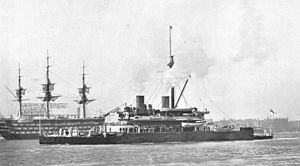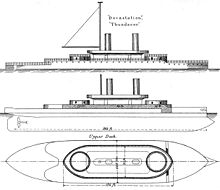Devastation class

|
|
|---|---|
|
|
|
| Builder: |
Pembroke Dockyard Portsmouth Dockyard |
| Period of service: | 1873-1909 |
| Displacement: | 9,180 ts standard 13,000 ts maximum |
| Length: | 87 m |
| Width: | 19 m |
| Draft: | 8 m |
| Drive: |
from 1890:
|
| Speed: | 13 kn 14 kn (after modernization) |
| Range: | 4,700 nautical miles (8,700 km) |
| Crew: | 410 |
| Armament: | Guns:
HMS devastation :
HMS Thunderer :
after renovation (1890):
Torpedo tubes (after modernization 1879/80):
|
| Armor: |
|
The Devastation- class was a two-unit class of armored ships in the Royal Navy .
The ships of the class were the first ocean-going warships that carried no sails . At the same time, they were the first ocean-going ships whose main armament was not installed in the hull, but rotatable on the ship's deck . They represent a first step on the way from the conventional ironclad with battery deck to the modern battleship. At the beginning of their service life they were the most powerful warships in the world.
history
At the beginning of 1869, the First Lord of the Admiralty , Sir Hugh Childers , asked the Royal Navy's chief designer, Edward Reed , to develop a large monitor that could travel under steam from Queenstown , Ireland to Halifax , Canada .
construction
Reed presented the first draft sketches in February 1869. In his opinion, however, the proposed displacement of 3,000 tons was inexpedient and he proposed an increase to 4,000 tons. At an immediately following conference of the Admiralty Board, agreement was reached that the main armament should consist of four 12-inch (305 mm) guns that would fire 600 pounds (270 kg) grenades . The guns were to be placed in two twin turrets with armor 14 inches (360 mm) thick. The Traversing range of the guns should be 280 degrees. The towers should be set up in the ship's center line in front of or behind the superstructure. The ship was again to be protected by belt armor 12 inches (300 mm) thick at the waterline .
The very low freeboard of 4 feet 6 inches (1.4 m) was accepted because the ships were now - contrary to the original requirements - intended for coastal protection and use in the relatively calm Mediterranean . For reasons of operational safety , two steam engines and two propellers were planned. Masts and sails were dispensed with from the start. The standing rigging of the masts would have restricted the directional range of the gun turrets and thus their combat characteristics. Drafts that provided an additional deck above the gun turrets, which carried the masts, led, among other things, to an increased center of gravity and were impractical. However, if the machinery failed, the ships were no longer maneuverable. One possible use was based on the existence of coal stations in the operating area. Sir William Jervois had already pointed out this problem . Ultimately, the transition to the steam-powered warship without sails, beginning with the Devastation class, led to the establishment of naval bases in the British colonies and dominions in America , Asia and Africa as well as along the routes to these colonies and dominions.
A copy of the intended towers was tested in Shoeburyness in May 1872. The 11 inch (280 mm) thick armor plates were lined with 15 inch (380 mm) thick teak and a 1.25 inch (32 mm) thick inner skin made of metal . The armor resisted fire from a 25-ton gun from a distance of 200 yards (around 180 m). A hit on the border of two armor plates punched a 7 inch (180 mm) diameter hole in the armor, but failed to penetrate it.
The belt armor was 12 inches (300 mm) thick and lined with 18 inches (460 mm) thick teak. The thickness decreased to 10 inches (250 mm) at the ends.
The loss of the HMS Captain in 1870 raised concerns about the stability of the tower ships. A committee was set up to determine whether the devastation would be safe. As a result of the meetings of the committee, the armored hull was enlarged by unarmoured extensions on the sides and stern in order to improve the stability of the ship at large angles of heel. The comfort for the crew also increased, as additional accommodation and, above all, latrines were set up in the annexes. Since the extensions were not armored, they were at great risk in battle. Their loss or serious damage must have made the ship less stable.
In 1871, tests were carried out on a nine-foot (2.7 m) long model of the ship in a pool of water. These experiments were later continued with an 18 foot (5.5 m) long model. After the completion of the HMS devastation , tests could be carried out with the ship. These also included flaps of 7 degrees. To this end, 400 men of the crew ran 18 times over the deck. During sea trials in rough seas, waves 6 - 8 m high resulted in heel angles of 14 degrees.
Fleet use
The ships were used in domestic waters and in the Mediterranean. After renovations in 1881 and 1891/92, they came to the First Reserve Fleet and were demolished in 1908/09.
Ships of the class
HMS devastation
The HMS Devastation was laid down on November 12, 1869 in Portsmouth Dockyard . The launch took place on July 12, 1871, the commissioning on April 19, 1873. In 1891 the 12-inch muzzle-loading guns were replaced by 10-inch breech-loading guns. The ship later came to the First Reserve Fleet and was canceled in 1908.
HMS Thunderer
HMS Thunderer was laid down in the Pembroke Dockyard on June 26, 1869 . The launch took place on March 25, 1871, the commissioning on May 26, 1877. On July 14, 1876 a boiler explosion occurred. The ship was traveling at full speed to test the maximum speed from Portsmouth Harbor to Stokes Bay when one of the rectangular boilers burst when the boiler pressure exceeded 30 pounds per square inch (210 kPa). 45 sailors were killed. 15 seafarers including the ship's commander, who was in the boiler room at the time, were killed immediately, a further 70 were injured, 30 of whom later died. The cause was determined to be a defective manometer and safety valves stuck due to corrosion , so that the overpressure could not be determined or automatically reduced. The accident led to the introduction of new cylinder boilers instead of the previously used case boilers . Furthermore, as a result of the disaster in 1879, the first official manual for machine systems (Steam Manual) was published.
Another serious accident occurred in January 1879 when the left cannon of the front tower exploded during live shooting in the Sea of Marmara . The reason was that the gun had been loaded twice after a failure. 11 sailors were killed in the explosion and 35 others were injured. In the aftermath of the accident, the Royal Navy gradually replaced the existing muzzle-loading guns with breech-loading guns. The procedures for loading the guns have also been improved. The HMS Thunderer itself was equipped with 10-inch rear loaders. The ship was then very popular in the fleet, King George V served during his time as Prince of Wales with the rank of lieutenant on this ship. With its wide hull, the ship was a stable gun platform. The phrase "stable like the old Thunderer " was used as kudos for newcomers to the fleet.
In 1881 the ship was equipped with triple composite steam engines. This reduced coal consumption by 80% and doubled the range. This conversion paved the way for the use of composite steam engines in the Royal Navy. Further renovations took place in 1890/92. In July 1909 the ship was sold and demolished.
Individual evidence
- ^ Conway's All the World's Fighting Ships, 1860-1905 , p. 37
- ↑ a b Alan McEwen: Historic Steam Boiler Explosions . Sledgehammer Engineering Press, 2009, ISBN 978-0-9532725-2-5 .
- ^ Brassey 1882, pp. 81-85
literature
- Sir Thomas Brassey, The British Navy, Volume II. London: Longmans, Green and Co. 1882
- David Brown: Warrior to Dreadnought: Warship Development 1860-1905 , Chatham Publishing.
- Roger Chesneau, Eugene M. Kolesnik (Editors): Conway's All The Worlds Fighting Ships, 1860-1905 , (Conway Maritime Press, London, 1979), ISBN 0-85177-133-5
- Sandler, Stanley: "Emergence of the Modern Capital Ship (Associated University Pressed, Neward, Del and London, 1979)
Web links
- HMS THUNDERER Boiler explosion - Accidents on HMS Thunderer (en) . Archived from the original on June 4, 2011. Retrieved September 20, 2013.
- Details of the boiler explosion on HMS Thunderer (en)

